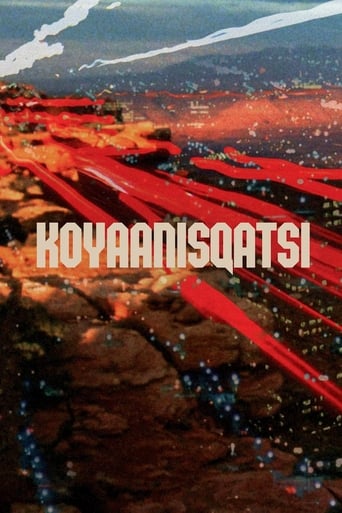



the audience applauded
It is not only a funny movie, but it allows a great amount of joy for anyone who watches it.
View MoreThe film makes a home in your brain and the only cure is to see it again.
View MoreMostly, the movie is committed to the value of a good time.
View MoreGodfrey Reggio tells viewers to take what they want from the trilogy of which Koyaanisqatsi (life out of balance) is the first part. Which is a little disingenuous.In 1982, industrialisation's effects on the environment were not the big news they are today. There were no camera drones, either, so getting spectacular aerial footage of the planet, whether of deserts or industrial landscapes was a more ambitious undertaking. If you watch it with the sound off, you see many now-commonplace variations of spectacular photography, time-lapse footage and slo-mo footage; cuts much longer than we're used to today, of all kinds of (all-American) beautiful landscapes and less beautiful cityscapes. The general message, ie that humankind isn't such a beautiful thing, isn't hard to discern.Now listen to the Philip Glass soundtrack without the visuals. Portentous, meandering, it never stays in one groove long enough to suggest that it's anything but background, ambient music. George Gershwin it ain't.Put them together, and you still don't feel anything but a mild approval for the vague message, and mild admiration for the hard work that must have gone into the editing, if nothing else. In 1982, Koyaanisqatsi was kind of left-field. Today it's left behind.
View MoreHumanity, nature and cycle. The director succeeds in presenting the audience in detail without dialogue in three parts. In this documentary you can question life, wars, people's anger, contempt, inequality and everything. You see a philosophy accompanied by awesome images. I think many people can get bored, but you have to be patient and watch. I want to open a separate parenthesis to the music of the documentary. The audiences are almost sticking to the seat. Do people pollute every environment? Where does humanity come from and where does it go?
View MoreWhile it is not a movie to be enjoyed by everyone, or in all situations, Godfrey Reggio's "Koyaanisqati" is a unique, vast, and exhilarating experience. It has no direct narrative and has many different meanings depending on who you ask, and achieves this through brilliant scenery and long shots, as well as a spectacularly done soundtrack. The soundtrack, performed by the Philip Glass Ensemble, compliments the visuals in such a way that the film would feel incomplete and less meaningful without it. Its use of repetition, crescendos, and silence overwhelms the film with intensity and serenity. It stands out to me as one of Koyaanisqatsi's greatest highlights.It can take a certain mindset or amount of patience to appreciate the effect that Reggio sets out to achieve, which is not a complaint but something to take note of. It has its own style that defies what a majority of popular films possess, and by doing so it seems that the film has a message that could be conveyed in no other way; it is designed in a way where it can't necessarily be defined only by words. That, to me, is the true beauty of the film.Overall, Koyaanisqatsi is a fantastic experience that is, while not extremely accessible, quite moving and beautiful in a very particular way. It provides a unique experience and message that proves the film to be well done and worthwhile for anyone to watch.
View MoreWhen I watch "Koyaanisqatsi," I don't want to breath. I don't want to blink. I want to see every frame, every change in its footage of clouds and traffic and bustling people. The intended meanings of Godfrey Reggio's film are suggested in its environmental imagery, in its focus on industrial civilization's high speed and large scale, and by the translation of the title: "life out of balance." But meanings, and the fact that the film's use of raw footage is more propagandistic than documentary, are of secondary concern. "Koyaanisqatsi" is a powerful work of art because is a pure sensory experience. Long cuts of sped-up landscapes and cityscapes are set to a Philip Glass score, and the effect is utterly mesmerizing. The first time I saw it, I only noticed at the end that my hands had been gripping the armrests. Comparing a film to a roller coaster is a cliché, and in this case it doesn't do the film justice; I've been on roller coasters that have less effect on my adrenaline than "Koyaanisqatsi."
View More